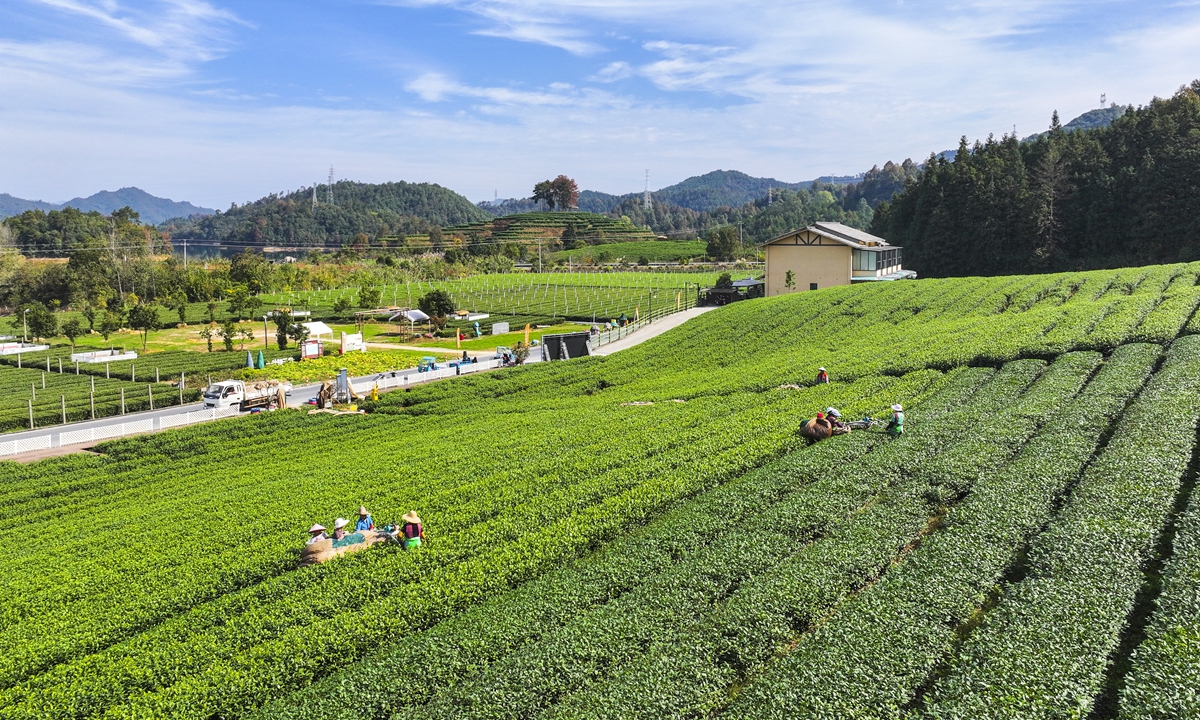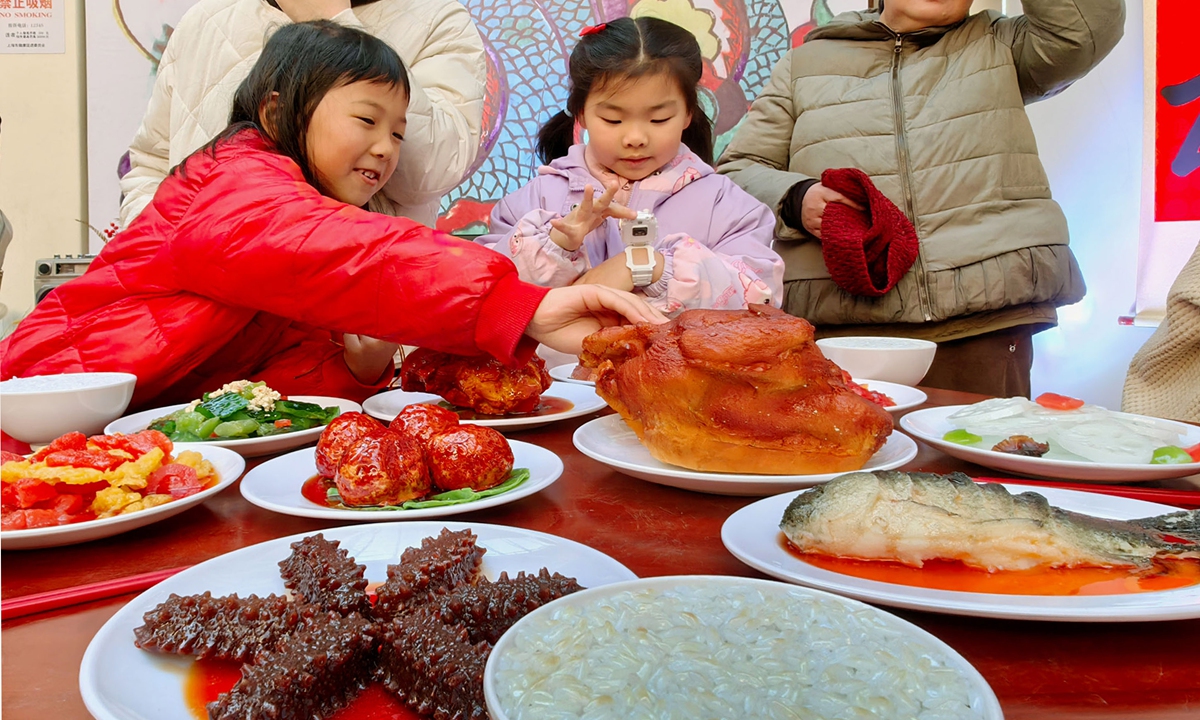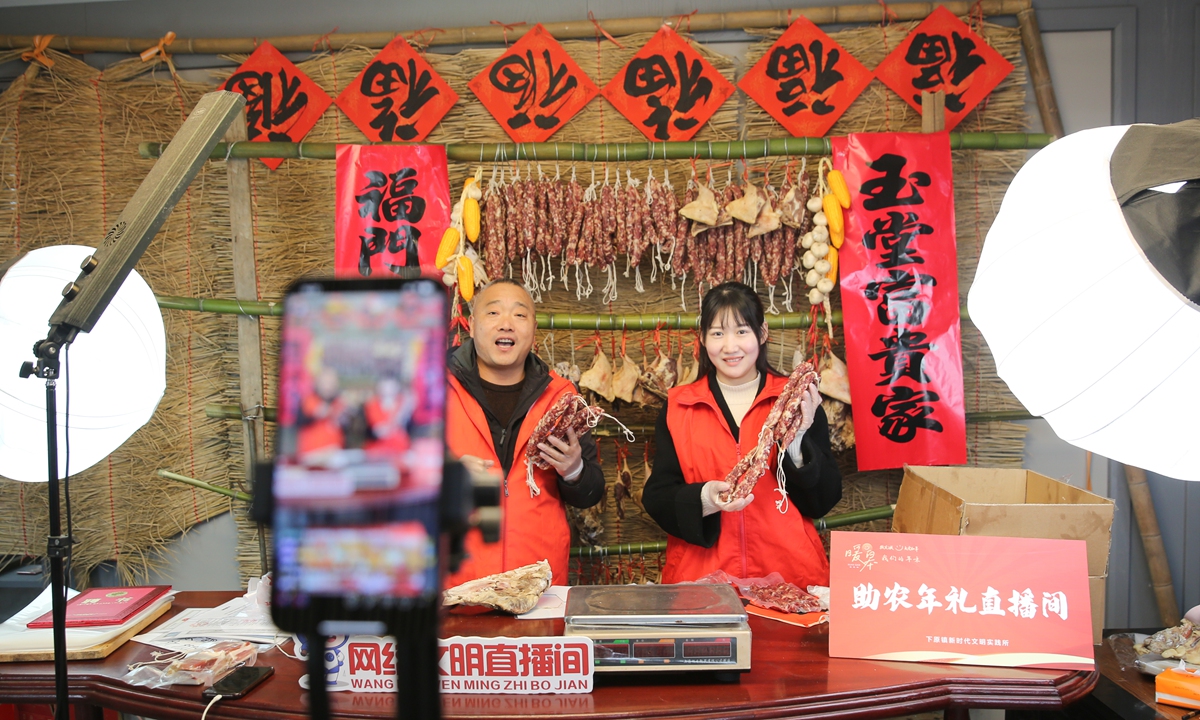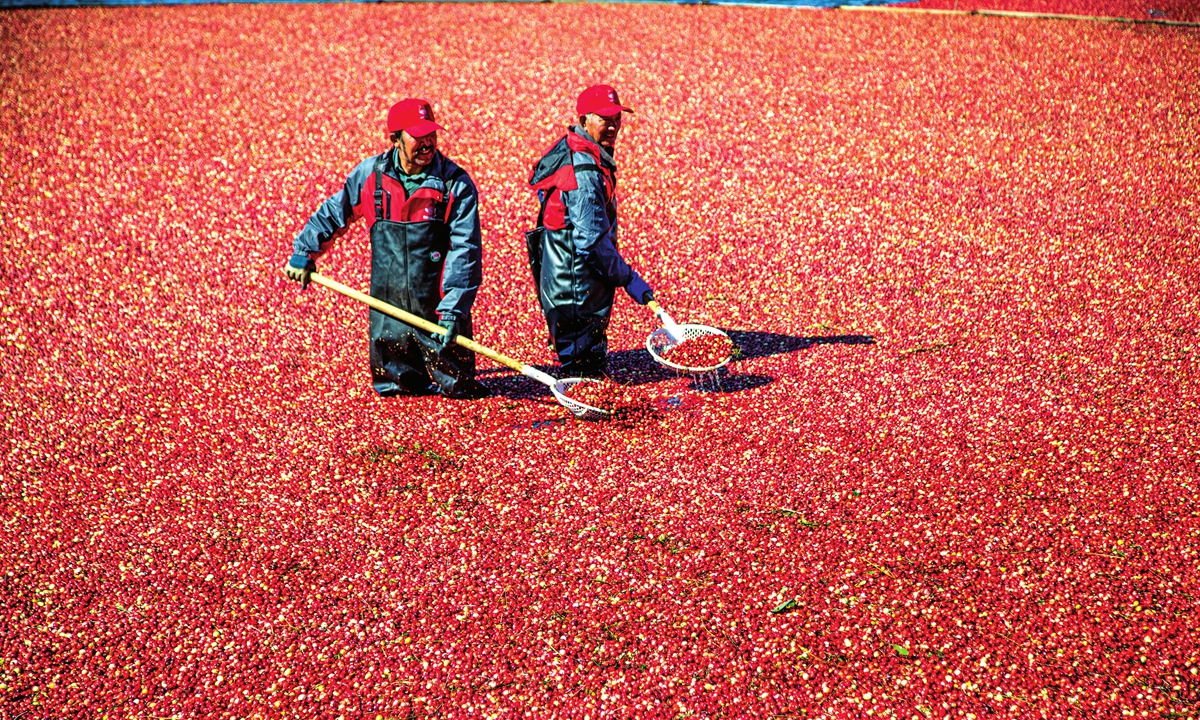Farmers collect cranberries in Northeast China’s Heilongjiang Province in September 2023. Photos: VCG
Kathy Peng never imagined that her birthplace in Southwest China’s Yunnan Province would be a production region for Scotch whisky.
Kathy, a seasoned world traveler with a discerning palate for international delicacies, now resides in Sanlitun, Beijing’s cosmopolitan heart. With the Spring Festival, or Chinese Lunar New Year, approaching, as every Chinese person would, she took to the internet, curating an array of goods for her family’s festive celebration.
To her astonishment, she discovered that what were once exotic imported foods have now found a home across China – Caviar from Southwest China’s Sichuan Province has supplanted the Baltic delicacy, while goose liver, a luxurious staple in French cuisine, can be bought from Anhui Province in central China; South American prawns are sourced from the arid yet latitudinally similar Gansu Province in Northwest China; Matcha, Japan’s signature flavor, now hails from Southwest China’s Guizhou Province.
“Discovering the world’s flavors right at our doorstep in China is like opening a treasure chest in your own backyard,” Kathy told the Global Times. “Before you know it, China has become a treasure trove of hidden global delicacies.”
China’s vastness is a marvel, spanning broad latitudes north to south and longitudes east to west. From the chilly conifer forests of the Northeast to the tropical azure waters of South China Sea, from the expansive deserts of the Northwest to the mountainous highlands of the Southwest… China nourishes a world of produce within its diverse terrains and climates.
As technology advances, even the toughest barriers to agricultural innovation are being broken down, allowing foreign crops to take root and thrive on Chinese soil, becoming powerful tools in the revitalization of rural areas.
The “No. 1 central document” released in January mentions that to effectively promote the revitalization of rural areas, it is necessary to adhere to the principles of boosting agriculture through industry, quality, and green practices. This involves advancing the coordinated development of agricultural production and both primary and deeper processing to enhance value conversion locally and regionally. Additionally, the document advocates for the development of online sales networks for rural specialty products.
On the Chinese internet, netizens have launched an “agricultural census” campaign, uncovering previously unknown local specialties from their hometowns and directly participating in the process of rural revitalization.

China-made whiskies are displayed at a shop in Emeishan, Southwest China’s Sichuan Province, on December 13, 2023.
Discovery of treasures
This winter, Harbin, the capital of Northeast China’s Heilongjiang Province, did not just freeze the rivers; it set the internet ablaze as the season’s first viral city. It is like discovering a secret level in a video game: Who knew cranberries were not just a Thanksgiving relic but actually grown right here in China as well?
This revelation was just the tip of the iceberg, leading to a treasure trove of hidden gems being unearthed.
On January 30, Taobao, one of the largest e-commerce platforms in China, rolled out the red carpet for the unsung heroes of the culinary world with its “Taobao Hidden Local Specialties Report,” featuring goose liver from Lu’an city, Anhui, and matcha from Tongren of Guizhou, followed by Wagyu beef from Qiqihar in Heilongjiang, and macadamia nuts (known in China as Hawaii nuts) from Lincang, Yunnan.
In Yunnan, alongside Lincang macadamia nuts, matutake cookies, Baoshan coffee, and Honghe blueberries have also gradually caught the public eye. Among them, the Tengchong dried cockroach is the most peculiar.
Dried cockroaches, due to their unique medicinal value, have become a new booming industry in Tengchong city. There are nearly a hundred stores on Taobao in Yunnan alone selling dried American cockroaches or cockroach powder, as well as products made from American cockroach as the main ingredient, like face soaps and masks.
The farthest inland northwest region has also astounded many netizens with its large-scale seafood farming properties for specialties such as Shaanxi’s hairy crabs, Qinghai’s rainbow trout, and Xinjiang Uygur Autonomous Region’s iceberg snow crabs and cold-water fish.
The Hidden Local Specialties Report is not just a shopping list; it is a call to adventure for foodies and a geography puzzle that actually tastes good. With local versions of global delicacies popping up faster than mushrooms after rain, it is clear: China’s menu, which is already huge and rich, has gotten an even bigger upgrade.

A tea farm in Hangzhou, East China’s Zhejiang Province which produces Motcha
Break through limitations
The “agricultural census” campaign has brought to light some fascinating facts about agriculture in China. For instance, it revealed that Heilongjiang has the largest cranberry plantation in Asia, Gansu produces South American prawns, and Anhui boasts the largest goose foie gras production base in China. These lesser-known facts have quickly spread through the internet, spotlighting some hidden champions in the agricultural sector.
In particular, the unexpected popularity of the city of Harbin has allowed many visitors from Southern China to experience northeastern-style hospitality. In a sign of gratitude, a total of 189 tons of freshly picked sugar tangerines from South China’s Guangxi Zhuang Autonomous Region were sent to Heilongjiang, and in return, Fuyuan city in Heilongjiang, the easternmost city in the Chinese mainland, gifted 100,000 cartons of locally produced cranberries to Guangxi. These exchanges of love between China’s north and south have introduced countless people to this small northeastern city and its unique fruits.
“Cranberry sales have suddenly skyrocketed this winter, with over 500 orders sold on January 7 and over 1,000 orders sold on January 8,” said Dang Linguang, the manager of the Ganfuyuan flagship store on Taobao, during a media interview.
According to data from Taobao, on January 10, searches for cranberries on the platform increased by 958 percent compared to the same period in 2023.
Dang noted that cranberries mainly grow between 40 and 50 degrees in north latitude, and the environmental requirements of the growth area are extremely harsh. For a long time in the past, cranberries in China were mostly wild, and it was hard to achieve large-scale cultivation.
Before 2010, China’s cranberry products were mainly dependent on imports. In 2014, Fuyuan successfully introduced cranberry cultivation from the US.
Fuyuan shares the same latitude as the main cranberry-producing areas worldwide and has a similar natural environment. After overcoming various planting technical difficulties, cranberries are finally cultivated on a systematic scale in the eastern polar land on the mainland.
Currently, the cranberry cultivation area in Fuyuan has expanded to 4,200 mu (280 hectares), making it the largest cranberry cultivation base in Asia. This not only breaks the US monopoly, which accounts for nearly 98 percent of global cranberry production, but also fills the gap in the market with domestically grown Chinese cranberries.
In 2023, Fuyuan’s cranberry production reached a record high of 3,000 tons, accounting for 40 percent of Asia’s cranberry production, and is expected to net sales of nearly 100 million yuan for fruit farmers.
“The development and transformation of China’s agricultural production mode has given many agricultural products unique competitive advantages,” Li Guoxiang, a research fellow at the Rural Development Institute of the Chinese Academy of Social Sciences, told the Global Times.
Li pointed out that in the past, China’s agricultural production was relatively slow due to the reliance on regional resource endowments. “However, in recent years, the modernization of agriculture in China has greatly freed agricultural production from the constraints of natural conditions. As a result, the types of industries in different regions have become more diverse, and many new local specialties have emerged,” he said.
Thanks to technological innovation, raising shrimp in the mountains is no longer a novelty in Gansu Province. Several years ago, cities like Baiyin, Wuwei, and Zhangye in Gansu began exploring the introduction of specialty aquaculture industries such as South America white shrimp, crabs, and rainbow trout. Since 2018, Jingtai county in Baiyin has been experimenting with the cultivation of South American shrimp in saline-alkali water.
According to Jingtai county’s fisheries technology extension service center, Baiyin has continuously made breakthroughs in the cultivation technology of South America white shrimp. In 2023, heating facilities were used to extend the shrimp’s growth period, making South America white shrimp more competitive in the market.
At present, rural industries across China have gradually established a sound industrial development system and formed a sense of integrated development of upstream and downstream industries, Li said.
“Although some of these characteristic industries are imported from outside, Chinese farmers combine their own characteristics and break regional planting barriers by relying on science and technology, and become a typical example of the rise of new agricultural innovation,” he noted.

Children sample Shanghai-style Chinese New Year food at an exhibition, on January 28, 2024.
Facilitate rural revitalization
In recent years, the potential of local specialties in promoting rural revitalization has been unleashed and once obscure local products are now emerging as powerful forces in transforming rural economies.
A search on popular Chinese e-commerce websites for local specialties yields tens of thousands of results, covering vast regions from the north to the south, and the east to the west. People can receive most of them within three days after placing an order. For some products that are not easily stored, cold-chain transportation is used to guarantee their freshness.
When Global Times reporters visited many rural areas in the country, they also learned from local officials and industry insiders that those local specialties have become an important financial source for locals and helped create employment opportunities as there is a strong need for skilled workers to produce, process, and market them.
Analysts pointed out that this also helps retain talent within the rural community. By the end of 2022, about 12.20 million people had returned to their hometowns to start businesses, according to official data. Among them, many chose the new agriculture industry.
By focusing on the production of local specialties, farmers are empowered to tap into niche markets and command higher prices for their products. This not only improves their income but also enhances their livelihoods, enabling them to invest in better farming practices and technologies, experts said.
However, with the changes in globalization and market demand, the local specialty industry faces new opportunities and challenges. On one hand, globalization has opened up new markets and expanded the reach of local specialties beyond regional boundaries. On the other hand, it also exposes local producers to competition from competent global players.
To overcome these challenges, local specialty producers need to focus on product differentiation, quality assurance, and effective marketing strategies to maintain their competitive edge, experts pointed out.
Meanwhile, there is also a growing environmental protection concern and the sustainable use of resources which are important for the long-term development of this industry.
“Local specialty producers should adopt eco-friendly production methods, minimize waste generation, and promote biodiversity conservation. Additionally, they should work closely with local communities and stakeholders to ensure that the development of this industry does not harm the ecological balance of the region. By prioritizing sustainability, the local specialty industry can thrive while preserving the natural resources that make these products unique,” Li said.

Villagers promote sausages and dried meats via an online platform at a community in Nantong, East China’s Jiangsu Province, on January 9, 2024.
